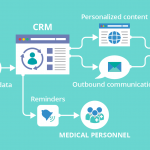How To Create Effective Lead Management Process – To organize the leads it is necessary to go through the planning. Lead management helps to improve potential and productivity. The management of leads is a process that is used to capture the leads, track the work, increases the results, etc. This is done in two ways either manually or with the help of software.

The management of leads offers many benefits such as –
- Time-saving.
- Automatically managing
- Boost efficiency
- Improve Sales planning.
- Keep eye on every action of the team
- Securing the data.
This covers all the actions that you take to acquire new prospects including lead capture, activity tracking, qualify, nurturing and passing them to the marketing sales team.
Why it is crucial to use lead management?
Having a process for managing the leads is important because without this you never make the new leads or manage the previous ones. If you do not have a plan for how to handle the system then your leads will fall eventually. This way saves your tons of time, money and resources too.
With the help of example let’s make it clearer. If you want to start a business then first you have to create the website, run advertisements and wait for the leads. When leads occur you have to keep the record of each lead, definitely you’ll make. It is possible that the volume of leads grows and you need to make more data who are interested in your work or not. Then it is very difficult to handle. Inefficient management of leads may harm your business and directly you will go towards the unsuccessful results.
How to achieve the effective lead management process: –
To prevent the lead leakage it is necessary to obtain the well lead tracking process. Some steps help you to create a lead tracking system.
Step 1: Identify your ideal lead as well as Its buyer journey.
Without knowing the audience, you cannot design an effective product. Because, if you do not know who is your client and what he/she wants, till that time you are unable to create the product. It is critical to identify who your ideal buyer’s. To create a lead, first, figure out the customer’s data which is known as “buyer persona”. The thing to include in the buyer’s persona is: –
- Job title
- Company size
- Demographics (age, sex, location)
- Income
- Short bio
- Goals
Once you build out your buyer’s persona then it’s the time to map out the process they go through to make a purchase decision, known as customer’s journey mapping.
Step 2: Generate leads.
It is can be a lot harder than it sounds but with the rights tools it does not have to be.
Lead generation tools: –
- Blog
- Guest blogging
- Social media
- Newsletter sign up
- Website SEO
- PPC ads
- Digital and print ads
- Costumer landing page
- Trade shows
- Speaking events
- Email marketing
- Webinars
- E-books and infographics
Step 3: Gather Intel about your leads and segment them.
Segmenting means to divides the leads based on qualifying content, better-targeted areas, etc.
There are different ways to the segment you lead.
- New or exciting lead status: – In this, a repeat visitor or brand new leads who have never interacted with your company before?
- Buyer persona: – which of your buyer persona do they best identify with?
- Product-specific: – In this, if you offer multiple products and services, which product gains the maximum attraction?
- Purchase history: – Which product did this lead previously?
- Engagement level: – How many times leads get interacted with your company?
Step 4: Score your leads
In this process, the best interest leads are qualifying and give them a score. Higher the score, the higher the chances of product conversion. Some examples of scoring are: –
- Location: – does the prospect live close to an area your product is sold?
- Engagement: – Does this prospect visit often to your website? Do they open all your emails?
- Buying stage: – which stage of sales funnels are they in?
Step 5: Nurture your leads.
At this stage, you know very well, who your leaders are and what they like and what they looking for. To get them to sell, you need to nurture them. For instance, if a lead needs the awareness of some service and product then provide them the education content that will help them to start to see your company as a solution that is the main goal of some business.
A leads management system is a key feature to start a business.
For any kind of business, it is necessary to plan all things like the client, product, etc. This will all happen when you’re planning is well and perfect because, no one wants to take the risk without any planning. As this may lead to fall your business and directly cause threat. Hence, managing leads does not compromise with the planning of business and offers the best results to accelerate the work.



